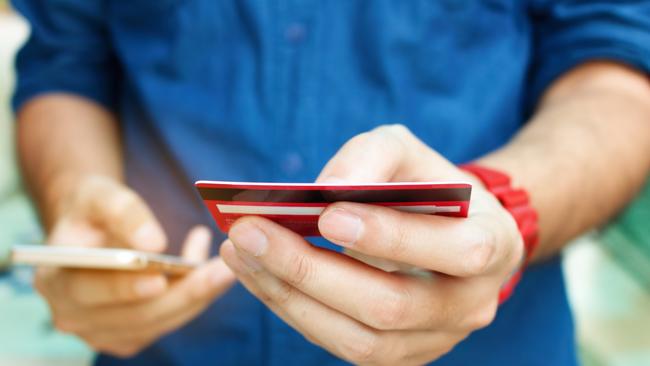Afterpay is costing millennials their house deposits
THE theory of buying now and paying later is good in theory, but when Afterpay is actually put to the test it seems consumers are losing more than a few dollars, writes Michelle Andrews.

Rendezview
Don't miss out on the headlines from Rendezview. Followed categories will be added to My News.
2.3 MILLION Aussie Millennials are addicted.
This addiction isn’t to drugs or alcohol or sex. It’s an addiction to — as the tagline suggests — ‘shopping now, enjoying now, paying later’.
It’s an addiction to Afterpay.
The zeitgeist’s answer to our parents’ beloved lay-by and credit cards, Afterpay allows you to have the stuff you want immediately, but pay it off later.
Launched in 2015 as the brainchild of Australian millennial Nick Molnar, Afterpay requires customers to cough up just 25 per cent of a purchase upfront, before paying the remaining balance in three fortnightly instalments by either direct debit or credit card. If you pay on time, you don’t pay a cent more than the price tag.
Of course, it’s not the only big player in the payment service game — rivals like Zip Pay and FuturePay are nipping at the heels of the tech-retail giant, waiting to feast on young people and our fetish for making our own bank accounts cry, but it is by far the most popular.
I would know. I am a millennial — and hardly a day goes by without my girlfriends, colleagues, or family members waxing lyrical about the wizardly magic of Afterpay.
The basic premise of ‘buy now, pay in a series of instalments’ isn’t all that dangerous (or magical). Cutting down large sums into smaller nuggets is clever — and being able to do so without copping additional charges is tantalising. If you’re a type A person who tracks every $4 latte in a Microsoft Excel spreadsheet, Afterpay might be your new budgeting friend when you need to buy a new pair of shoes or work clothes.

Yet in so many cases the opposite is true; it will enable extravagant, exorbitant, and excessive spending on exclusively non-essential items. And that’s before you consider the $10 late fees that pile up when a customer fails to make a scheduled repayment.
Victoria Devine, the founder of millennial financial advisory company Zella, has seen clients be rejected from home loans because of their infatuation with — and misuse of — Afterpay.
“While it’s not a credit card, Afterpay is still seen as a credit liability,” Devine tells RendezView.
“If you’re applying for a home loan you need to disclose that information. And, unfortunately, Afterpay is something so many people forget about, despite it being debt. If you don’t disclose it when you’re applying for a home loan, you will be rejected.”
With the big four banks now clueing on to payment scheme debts, Devine concedes, “you can be seen as someone who’s not financially stable” if your Afterpay account looks a little bit too active.
Currently, Afterpay accounts for 25 per cent of all Australian retail sales made online, and 8 per cent of all online sales. But given its recent rollout across Kmart stores, those numbers are likely to continue soaring.

And what’s perhaps most frightening is the ease with which the payment system infiltrates our spending habits. For starters, three years in, it’s unclear what Afterpay’s vetting and credit approval process is (banking giant Credit Suisse recently likened the company to a payday lenders — something Afterpay adamantly rejected). We do know, though, that approval takes little more than a few minutes and can be done in-store or online.
As for spending limits, that too is somewhat unclear. According to a statement on its website updated earlier this week, “For those who have only recently joined Afterpay, spending limits will generally be smaller. However, the longer you are with us, spending responsibly and making repayments on time, your spending limits may increase.”
Then, the minute you sign up for Afterpay and use it for the first time, it becomes the default method of payment, allowing you to purchase again and again with just the click of a button.
And while the theory of paying come instalment time is all well and good, Afterpay’s most recent annual report tells a different story, showing the amount it cashes in on late fees surged by 365 per cent in the last financial year, with Australians now handing over $28.4 million for the privilege and “convenience” of purchasing non-essential items on an instalment plan.
Also a millennial herself and, given her finance credentials, probably a lover of Excel spreadsheets — Devine has been approached by rafts of young people in the last 12 months.

Each is desperately looking for a map to navigate themselves out of the Afterpay hole they unwittingly burrowed down.
“One of my clients is in her mid-twenties, and just went nuts on Afterpay over the last year or so,” Devine says.
“Now she’s paying $950 a month just on her Afterpay. We’ll absolutely get through it, and thankfully that is all interest free for her, but she’s just gotten herself in so deep.”
Really, the financial adviser says, the red flag of risky Afterpay behaviour is glaring.
“If you’re using buy now, pay later, to pay for something you otherwise couldn’t afford, you’re doing it wrong. You’ve got it wrong.”
Ultimately, she believes Millennials need to re-evaluate how they are spending money on Afterpay, and consider how that money could be better used to build their future.
“If [that client] had $950 to invest instead of spend on Afterpay, that’s a lot of money, right? If she saved that amount every month for 10 years, at an interest rate of 7 per cent which is standard in the market, she’d have $166,000,” Devine explains.
“That money she’s spending on Afterpay could be a portfolio when she retires of more than $2 million.”
For now, it seems, some members of my generation have a choice to make: cute clothes now, or a cute house on the beach when we’re 65.
The problem is, so many don’t realise they’ve already chosen.
Michelle Andrews is a freelance writer and podcast host from Melbourne. Follow her on
